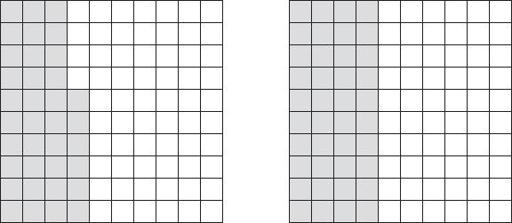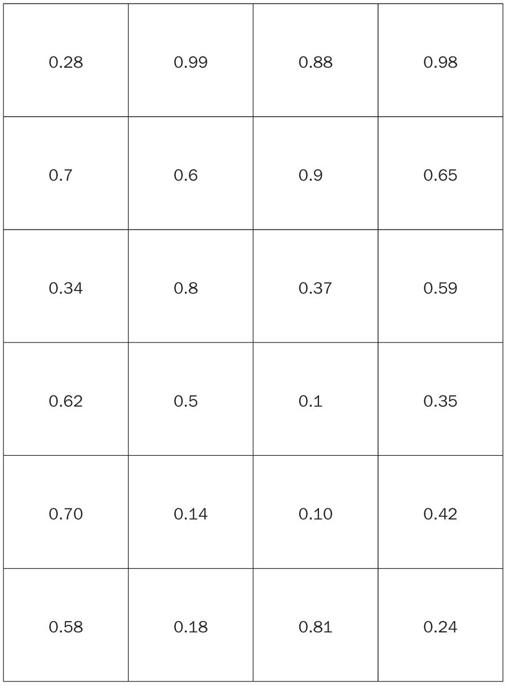Teaching the Common Core Math Standards With Hands-On Activities, Grades 3-5 (41 page)
Read Teaching the Common Core Math Standards With Hands-On Activities, Grades 3-5 Online
Authors: Judith A. Muschla,Gary Robert Muschla,Erin Muschla-Berry
Tags: #Education, #Teaching Methods & Materials, #Mathematics, #General

To use the number line to compare decimals, students should compare the positions of the decimals. The larger number is located to the right of the smaller number.

For example, to compare 0.4 and 0.38, locate their positions on the number line. Because 0.4 is to the right of
To compare 0.36 and 0.4 on graph paper, consider the model below. Note that 0.4 equals 0.40; therefore

Activity: Decimal Battle
Working in pairs or groups of three, students will play a game called “Decimal Battle.” Players pick cards on which decimals are written in either tenths or hundredths. They will compare the decimals and the player with the higher decimal takes the cards. At the end of the game, the student with the most cards in each pair or group wins. Students will then sketch models of their cards on number lines or on graph paper to justify their results.
Materials
Scissors; rulers; markers; crayons; colored pencils; two or three sheets of graph paper; reproducible, “Decimal Battle Cards,” for each pair or group of students.
Procedure
1.
Hand out copies of the reproducible. Explain that it contains 24 cards on which decimals are written in either tenths or hundredths. Students are to use the cards for a “decimal battle.”
2.
Tell students to cut out the cards. They should shuffle them and place them face down on the desk.
3.
Explain the rules: each student selects a card from the pile, one card at a time. After the students have each selected a card, they are to compare the values of the decimals on their cards. The student whose card has the higher value takes both cards. In the case that the cards are of equal value, the two cards are set aside. Each student now selects another card and the process is repeated, with the student who has the higher card collecting both cards. Suggest that upon collecting cards, students keep the cards grouped in sets. This will make it easier to complete the next part of the activity. At the end of the game, the student who has the most cards is the winner.
4.
Explain that after they have finished the game, each student is to select one pair of cards and use a number line or graph paper to sketch a visual model showing which decimal has the greater value. Students should also write an inequality that is represented by their model.
Closure
Check students' models and announce the winners of the decimal battle. Allow students to share their models with others. Display the models showing the comparisons of decimals. As an extension, you may have your students reshuffle the cards and play another round.
Decimal Battle Cards
Measurement and Data: 4.MD.1
“Solve problems involving measurement and conversion of measurements from a larger unit to a smaller unit.”
1. “Know relative sizes of measurement units within one system of units including km, m, cm; kg, g; lb, oz; l, ml; hour, min, sec. Within a single system of measurement, express measurements in a larger unit in terms of a smaller unit. Record measurement equivalents in a two-column table.”
Background
In the United States, students should be familiar with both customary and metric units of measurement. Encourage your students to become familiar with the common units of measurement in both systems. Suggest that they refer to measurement charts, which should be included in their math textbook, whenever they are unsure of a measurement.
Activity: Our Two Units of Measurement
This is a two-day activity.
Working in groups, students will explore the relationship of two units of measures according to specific criteria, and then create a poster and present their results to the class.
Materials
Scissors; rulers; markers; crayons; poster paper for each group; math texts; reference books on metric and customary measurement units for each group. Optional: Computers with Internet access.
Preparation
Before beginning this activity, obtain books from your school library on measurement systems and measurement units.
Procedure
Day One
1.
Divide your class into 10 groups. Assign each group to one of the pairs of measures below. (
Note:
For small classes, it is not necessary to assign all of the pairs of measurements.)
| Group 1: kilometers and meters | Group 6: feet and inches |
| Group 2: meters and centimeters | Group 7: pounds and ounces |
| Group 3: kilograms and grams | Group 8: minutes and seconds |
| Group 4: liters and milliliters | Group 9: hours and minutes |
| Group 5: gallons and quarts | Group 10: days and hours |
2.
Explain that groups are to create a poster that shows the relationship of their two units of measure. They should include the following information on their posters:
- The size or amount of each unit compared to the other. For example, in terms of pounds and tons, 2,000 pounds = 1 ton.
- An example of an item that can be measured in terms of the larger unit.
- An example of an item that can be measured in terms of the smaller unit.
3.
Explain that they are also to include a two-column table on their posters that shows the relationship of the two units for at least 5 rows. For example:and so on.



